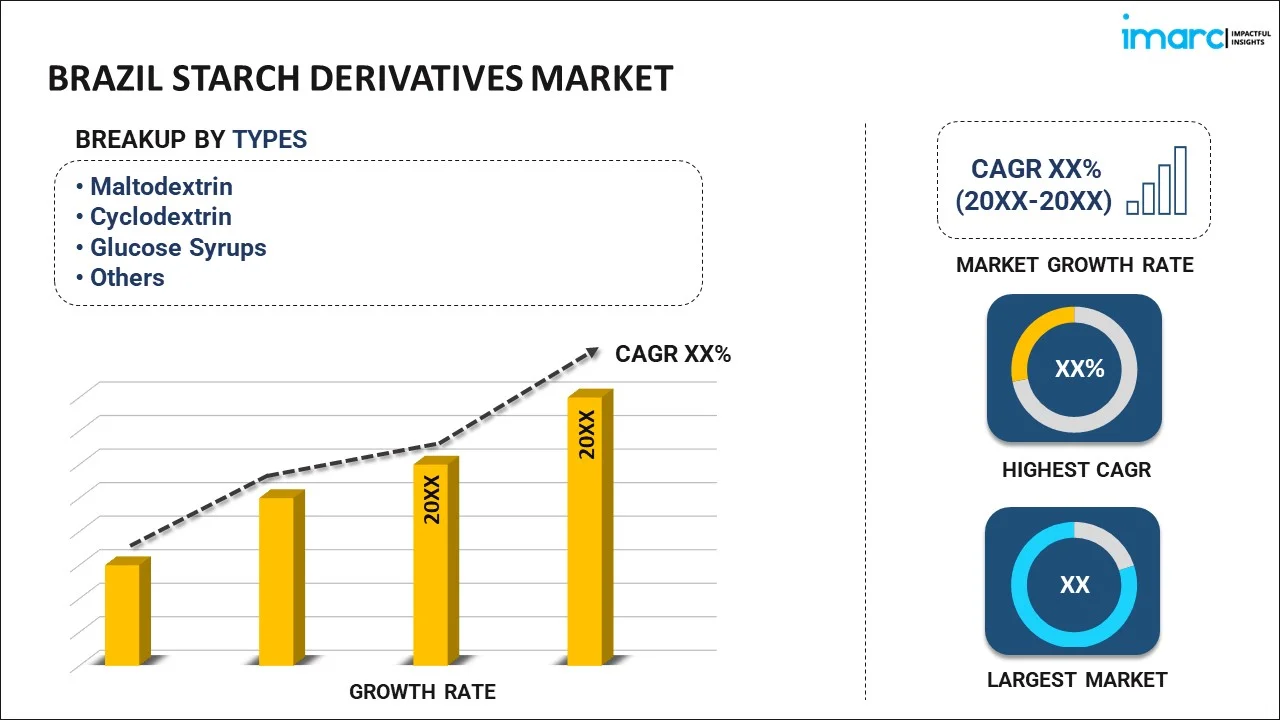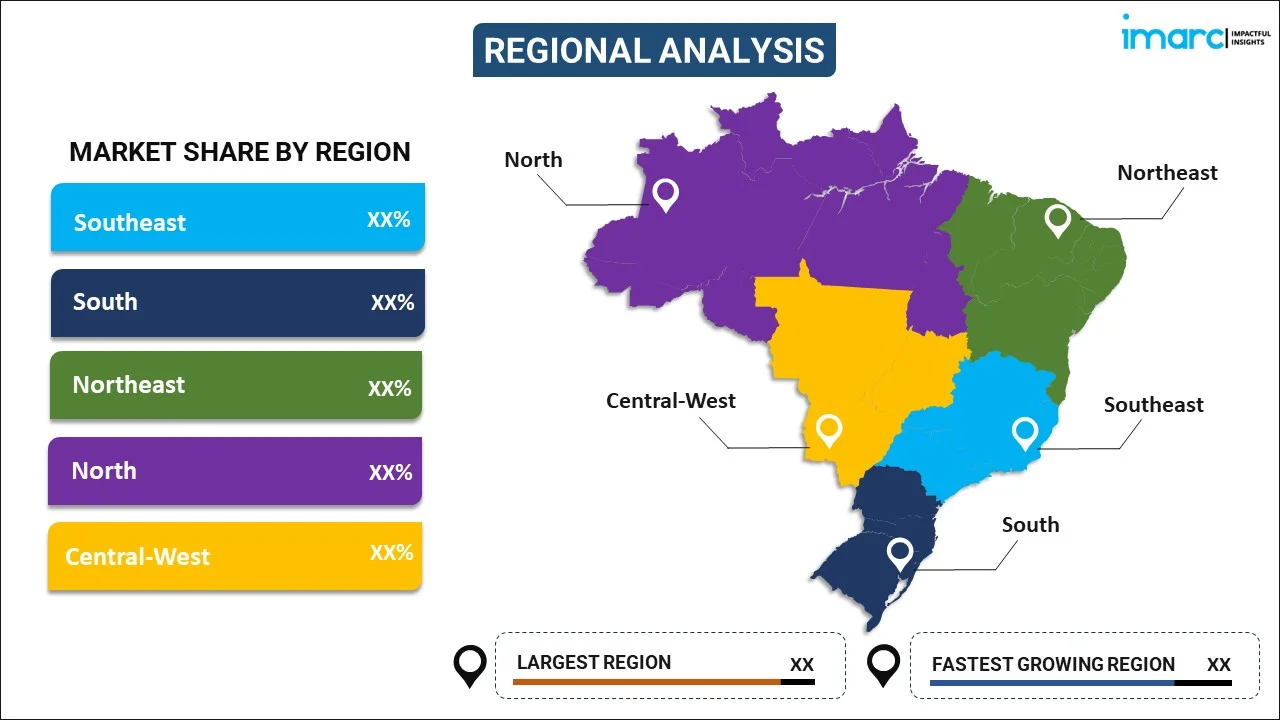
Brazil Starch Derivatives Market Report by Type (Maltodextrin, Cyclodextrin, Glucose Syrups, Hydrolysates, Modified Starch, and Others), Application (Food and Beverage, Feed, Pharmaceutical Industry, Cosmetics, and Others), and Region 2025-2033
Market Overview:
Brazil starch derivatives market size reached USD 1,252 Million in 2024. Looking forward, IMARC Group expects the market to reach USD 1,721 Million by 2033, exhibiting a growth rate (CAGR) of 3.6% during 2025-2033. The growing demand for clean-label, natural, and healthy food products, rising popularity of gluten-free and allergen-free diets, and increasing innovations in extraction and processing technologies represent some of the key factors driving the market.
|
Report Attribute
|
Key Statistics
|
|---|---|
|
Base Year
|
2024
|
|
Forecast Years
|
2025-2033
|
|
Historical Years
|
2019-2024
|
|
Market Size in 2024
|
USD 1,252 Million |
|
Market Forecast in 2033
|
USD 1,721 Million |
| Market Growth Rate 2025-2033 | 3.6% |
Starch derivatives are modified forms of starch resulting from chemical or enzymatic treatments that alter the molecular structure of starch molecules. They comprise modified starches, which undergo chemical or physical modifications to improve their functional properties. They also consist of hydrolyzed starch and esterified starch that improve its solubility and stability. They include cationic starch and resistant starch, which resists digestion in the small intestine, offering health benefits as a dietary fiber. They can be tailored to provide specific functions, such as thickening, stabilizing, and gelling, in various applications. They are used to create textured vegetable proteins, meat analogs, and other food products, as they can replace more expensive ingredients and improve production efficiency. Starch derivatives also allow manufacturers to meet specific requirements for their products. They are used as a binder in tablet formulations and in the manufacturing of capsules. They are also employed as a surface sizing agent and binder in paper production. They are essential in the oil and gas industry as starch derivatives are incorporated in drilling fluids as a viscosifier.
Brazil Starch Derivatives Market Trends:
At present, the increasing demand for clean-label, natural, and healthy food products represent one of the crucial factors impelling the growth of the market in Brazil. As health-conscious people are becoming more discerning about their dietary choices, they are actively seeking products made from starch derivatives, such as modified starches and starch sweeteners, which are perceived as more natural alternatives to traditional food additives. Moreover, the rising consumption of gluten-free and allergen-free diets is accelerating the adoption of starch derivatives as functional ingredients in a wide range of food and beverage applications. The sustainability trend is gaining momentum and encouraging manufacturers operating in the country to invest in eco-friendly production processes and raw material sourcing. Starch derivatives derived from renewable sources, such as corn, potatoes, and cassava, are aligning with these sustainability goals. Apart from this, the expansion of the biofuel industry, driven by environmental concerns and government initiatives to reduce greenhouse gas emissions, is catalyzing the demand for starch derivatives as bioethanol production relies heavily on starch-based feedstocks. Furthermore, increasing innovations in extraction and processing technologies are enhancing the efficiency and quality of starch derivative production. Additionally, the rising employment of starch derivatives to produce adhesives and glues is offering a favorable market outlook. Besides this, manufacturers are investing in research and development (R&D) activities to create innovative starch derivative products, responding to the changing needs of various industries.
Brazil Starch Derivatives Market Segmentation:
IMARC Group provides an analysis of the key trends in each segment of the market, along with forecasts at the country level for 2025-2033. Our report has categorized the market based on type and application.
Type Insights:

- Maltodextrin
- Cyclodextrin
- Glucose Syrups
- Hydrolysates
- Modified Starch
- Others
The report has provided a detailed breakup and analysis of the market based on the type. This includes maltodextrin, cyclodextrin, glucose syrups, hydrolysates, modified starch, and others.
Application Insights:
- Food and Beverage
- Feed
- Pharmaceutical Industry
- Cosmetics
- Others
A detailed breakup and analysis of the market based on the application have also been provided in the report. This includes food and beverage, feed, pharmaceutical industry, cosmetics, and others.
Regional Insights:

- Southeast
- South
- Northeast
- North
- Central-West
The report has also provided a comprehensive analysis of all the major regional markets, which include Southeast, South, Northeast, North, and Central-West.
Competitive Landscape:
The market research report has also provided a comprehensive analysis of the competitive landscape in the market. Competitive analysis such as market structure, key player positioning, top winning strategies, competitive dashboard, and company evaluation quadrant has been covered in the report. Also, detailed profiles of all major companies have been provided.
Brazil Starch Derivatives Market Report Coverage:
| Report Features | Details |
|---|---|
| Base Year of the Analysis | 2024 |
| Historical Period | 2019-2024 |
| Forecast Period | 2025-2033 |
| Units | Million USD |
| Scope of the Report | Exploration of Historical and Forecast Trends, Industry Catalysts and Challenges, Segment-Wise Historical and Predictive Market Assessment:
|
| Types Covered | Maltodextrin, Cyclodextrin, Glucose Syrups, Hydrolysates, Modified Starch, Others |
| Applications Covered | Food and Beverage, Feed, Pharmaceutical Industry, Cosmetics, Others |
| Regions Covered | Southeast, South, Northeast, North, Central-West |
| Customization Scope | 10% Free Customization |
| Post-Sale Analyst Support | 10-12 Weeks |
| Delivery Format | PDF and Excel through Email (We can also provide the editable version of the report in PPT/Word format on special request) |
Key Questions Answered in This Report:
- How has the Brazil starch derivatives market performed so far and how will it perform in the coming years?
- What has been the impact of COVID-19 on the Brazil starch derivatives market?
- What is the breakup of the Brazil starch derivatives market on the basis of type?
- What is the breakup of the Brazil starch derivatives market on the basis of application?
- What are the various stages in the value chain of the Brazil starch derivatives market?
- What are the key driving factors and challenges in the Brazil starch derivatives?
- What is the structure of the Brazil starch derivatives market and who are the key players?
- What is the degree of competition in the Brazil starch derivatives market?
Key Benefits for Stakeholders:
- IMARC’s industry report offers a comprehensive quantitative analysis of various market segments, historical and current market trends, market forecasts, and dynamics of the Brazil starch derivatives market from 2019-2033.
- The research report provides the latest information on the market drivers, challenges, and opportunities in the Brazil starch derivatives market.
- Porter's five forces analysis assist stakeholders in assessing the impact of new entrants, competitive rivalry, supplier power, buyer power, and the threat of substitution. It helps stakeholders to analyze the level of competition within the Brazil starch derivatives industry and its attractiveness.
- Competitive landscape allows stakeholders to understand their competitive environment and provides an insight into the current positions of key players in the market.
Need more help?
- Speak to our experienced analysts for insights on the current market scenarios.
- Include additional segments and countries to customize the report as per your requirement.
- Gain an unparalleled competitive advantage in your domain by understanding how to utilize the report and positively impacting your operations and revenue.
- For further assistance, please connect with our analysts.
 Inquire Before Buying
Inquire Before Buying
 Speak to an Analyst
Speak to an Analyst
 Request Brochure
Request Brochure
 Request Customization
Request Customization




.webp)




.webp)












